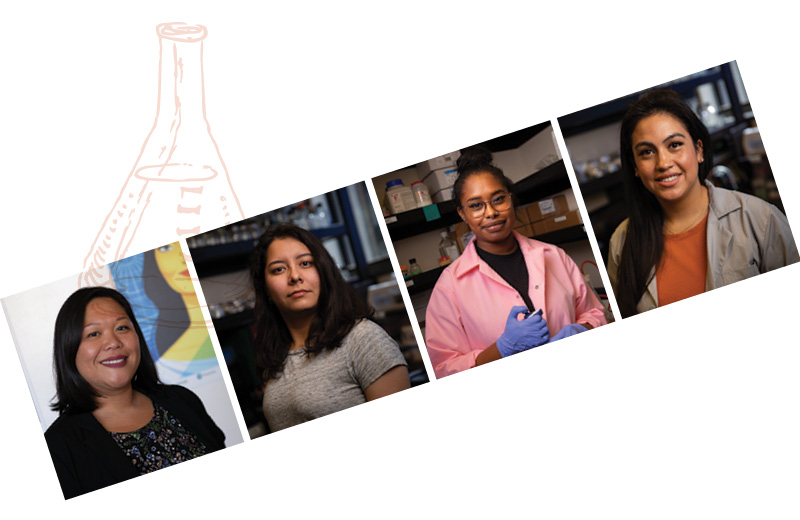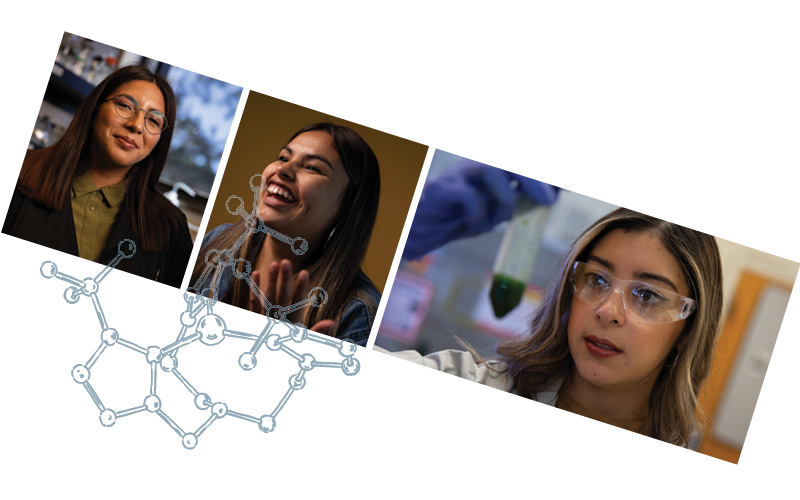
By Patrick Monahan
Photos by Wil Matthews
Women of color can be hard to find in biomedical research — but the SF BUILD program is doing something about it
When Cathy Samayoa was attending community college, a San Francisco State University professor came to give a lecture in one of her chemistry courses. That professor was Carmen Domingo, now the dean of the College of Science & Engineering — and for Samayoa, it was eye-opening just to see another Latina who was a scientist.
“It was like, these people exist?” Samayoa explains. “I always had great mentors, but they were white males. I felt like they were amazing mentors, but I’m not like them.”
That lecture inspired her to apply to San Francisco State. Three degrees later, she’s now an adjunct assistant professor and has for years been one of several leaders of the SF BUILD (Building Infrastructure Leading to Diversity) program, which aims to make biological research and medicine more diverse. Many of the scientists leading the program are also women of color, working to change the discipline from the inside out.
SF BUILD began in 2014 and was renewed this August with a grant from the National Institutes of Health (NIH) for $14.8 million. It’s one of 10 NIH-funded BUILD programs across the country, each of which is testing a different approach to promoting diversity. SF BUILD stands out by pivoting away from attempts to fix any perceived “deficits” in underrepresented students — the skills or training that they supposedly lack. Instead the program aims to change the University to be more welcoming by transforming the research and teaching environments on campus.
SF State and the University of California, San Francisco (UCSF) collaborate on SF BUILD, taking advantage of the respective strengths of each institution. The partnership gives SF State students greater access to UCSF’s vibrant research environment and facilities while giving UCSF professors the chance to recruit students from SF State’s diverse student body.
From left to right: Audrey Parangan-Smith, Jessica Magaña, Imani Robinson, Cathy Samayoa

“As the two major educational institutions within San Francisco, our collaboration is particularly powerful for improving both educational opportunities and research related to health for all communities in San Francisco,” says Kirsten Bibbins-Domingo, SF BUILD’s principal investigator at UCSF and the vice dean for population health and health equity at UCSF’s School of Medicine.
“We’re focusing on the ways we can make a change institutionally and the ways we can work with our faculty to change the lens of what can help our students from underrepresented groups succeed in science,” adds SF BUILD Assistant Director Audrey Parangan-Smith.
“Everyone’s Trying to Push Me Out”
Scientific fields often aren’t welcoming for people from underrepresented groups. Coupled with a lack of diversity, the stark power dynamics present in academic science expose women and people of color to regular implicit bias and even overt racism and sexism. After Samayoa graduated with a master’s degree from SF State, she left to study at a less diverse research-focused university. There, she had to contend with constant worries of having her research ideas taken by others along with learning to be more assertive and dealing with self-doubt — all challenges that women of color often face on top of the already considerable demands of being a scientist.
“There were so many times I thought, ‘I can’t do this,’” Samayoa says. “I can do the science, I can do the hours. But I can’t do the constant feeling that everyone’s trying to push me out because I don’t belong.”
“We say these populations are hard to reach, but perhaps it’s about who’s doing the reaching.”
Experiences like these can cause women and people of color to leave academic science altogether. According to the National Center for Education Statistics, while women from underrepresented backgrounds make up 10% of those who earn bachelor’s degrees in the biomedical sciences, their representation drops precipitously at the doctorate level. The gap is even wider in leadership positions: Women from underrepresented backgrounds make up less than 1% of the country’s full professors.
When the science workforce lacks diversity, the public suffers. To address disparities in health between different racial and ethnic groups, researchers need to recruit study participants from those groups — something the discipline has struggled with due in part to a lack of diversity in researchers and practitioners. “You have to have diversity in participants,” says Tung Nguyen, a professor of medicine at UCSF and a new leader of SF BUILD. “Otherwise, the lessons you learn are not useful.”
But when the researchers themselves come from the communities they’re studying, things are different. In Samayoa’s work with Latina breast cancer survivors, she had a 85% retention rate of participants, and 98% gave DNA samples for the research, something that requires the kind of trust that researchers have not always been able to earn. It’s the reason why Latinas are one of the groups referred to in the scientific literature as “hard-to-reach populations.”
The same story has played out in other SF BUILD research projects led by scientists who have roots in the community. “We say these populations are hard to reach, but perhaps it’s about who’s doing the reaching,” Samayoa says.
Science Mom — and Much More
In its mission to make biological research and medicine more diverse, SF BUILD organizes and supports programs that reach every level of the University. Through one, faculty and staff train University instructors on how to avoid language that’s been shown to impact the performance of students from underrepresented groups. Through another, professors meet to discuss research on teaching so they can better serve their students. SF BUILD also supports a two-year student research training program and other mentorship programs as well as teams of researchers studying health disparities.
Efforts in SF BUILD to create a welcoming space in higher education extends to physical spaces as well. Recently, the SF BUILD community space went through a renovation, a collaboration with SF State Associate Professor of Design Hsiao-Yun Chu. Now hanging on the walls are images of women of color in science.
Collectively, the goal of these programs and others is to build on SF State’s history of activism and create a community of students and faculty empowered to enact change, says SF BUILD Director and SF State Professor of Biology Leticia Márquez-Magaña. “We’re a catalyst — that’s the grassroots approach,” she explains. “That’s what 50 years of history at SF State has taught us.”

Their approach may be bottom-up, but the project’s leaders also lead by example. Márquez-Magaña rejects common stereotypes about scientists, instead embracing a title bestowed on her by students due to her supportive nature and dedicated mentorship: “science mom.”
From left to right: Maria Cruz, Mireya Arreguin, Andrea Morales
“I love that,” she says. “But in our society, being a mom is definitely something less than. It’s just all antithetical to what they see as success.” That’s despite the fact that she directs SF BUILD, leads a successful research lab, actively publishes research and has been involved with bringing more than $70 million in grant funding to the SF State campus over the years.
But it’s important to Márquez-Magaña that she continues to set an example of a different way that scientists can be. “If you conform to a system that’s inherently inequitable, then you can’t challenge that, because you’re part and parcel of the system that you’re trying to challenge,” she says.
Her students respond to that, too. Rebecca Mendez is a lab manager in the Health Equity Research Lab at SF State and has worked with Márquez-Magaña since she was an undergraduate. “I’ve seen all these different generations of students come in and go out there into the world,” the majority of whom have continued on to Ph.D. programs or jobs in science industries, she says. “I feel like she places a seed in you, and it grows. And it only gets stronger and stronger.”
Agents of Change
The next five years of SF BUILD will bring an increased effort to institutionalize programs — finding ways to ensure they’ll live on after the five-year funding period — and will also see a shift in focus. In its first iteration, SF BUILD was oriented around reducing stereotype threat, a phenomenon where students underperform due to a fear of confirming negative stereotypes that others have about them. The next phase of the project will examine deeper structural issues that affect students from underrepresented groups.
“From the data we’ve collected, it’s clear that the chronic racism students experience in STEM is bad for their emotional and mental health and causes underperformance in the classroom,” says Márquez-Magaña. The project’s new framework focuses on building awareness and acceptance of these issues in the campus community and prompting action to address them.
Already, the program’s leaders say, they’ve seen a shift in how faculty members talk about the challenges faced by their students. SF BUILD researchers have also worked to spread their findings nationally through research papers, books and workshops. Over the next five years, they’ll continue seeking new ways to measure the program’s impact and inform other institutions of their findings, ensuring that the systems they’ve created to catalyze change can be replicated elsewhere.
Meanwhile, students attracted to SF BUILD programs because of the environment they create are moving up through the ranks. In 2017, student Mireya Arreguin participated in an SF BUILD-funded program called the Alma Project, which uses reflective journaling as a way to create a more welcoming environment in science classrooms. “It really helped me connect with other people who I didn’t know were like me,” she says. Now Arreguin is leading the Alma Project — and she’s also joined SF BUILD’s two-year student training program, the SF BUILD Scholars. Alums of the program have gone on to Ph.D. programs around the country, bringing with them SF BUILD’s unique approach to diversifying the discipline.
To describe the changes she hopes to see in science, Márquez-Magaña uses a concept from nature. For “ecological succession” to take place — for one kind of ecosystem to shift to another — sometimes the existing landscape has to be disturbed first.
“We want to disrupt current practices in science to create the space for new ones that are inclusive of all students,” Márquez-Magaña explains. “We’re all sparks, and we expect the agents of change in SF BUILD to go out there and start a fire.”